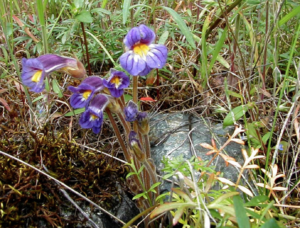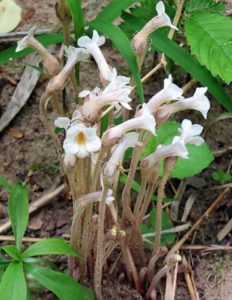Common Name: One-Flowered Broom Rape, One-flowered Cancer Root, Ghostpipe, Naked Broomrape
Specific Name: Orobanche uniflora
Known Occurrence at Taylor Point:
Map Areas: Beach 1F
Category: Native, Herbaceous Plant

Ecological Considerations:
Orobanche uniflora, commonly known as One-Flowered Broom-Rape is an annual, parasitic plant. One plant produces up to five flowering stalks, each of which bears a single, fragrant, white-to-lavender flower with a bilabiate corolla and no bractlets. The stems are covered with glandular hairs. The calyx of the flower is cleft deeply into five subequal lobes, which are greater than the tube. The flowers are cross-pollinated by bees.
This parasitic plant gets its nourishment from the roots of other plants, often stonecrops (Sedum) and plants in the families Asteraceae and Saxifragaceae, as well as sunflowers, goldenrods, and others. One-Flowered Broom-Rape does not produce chlorophyll and as a result has no green portions. Its underground stem is short, usually 1-1 1/2 inches long.
A One-Flowered Broom-Rape seedling must find a suitable host plant within a few days of germinating or it will die. The One-Flowered Broom-Rape underground stem responds to chemicals released by the growing roots of host species. Once a host plant is located, the One-Flowered Broom-Rape’s root hairs exude an adhesive substance that attaches its roots to those of the host plant. Enzymes break down the cell walls of the host, and a tuber-like connection (haustorium) forms between the vascular tissue of the two plants, allowing the movement of water, minerals and carbohydrates to flow in one direction, from host to parasite.
One-Flowered Broom Rape is commonly found in damp woods and thickets, meadows, fields, disturbed areas and by stream banks. It is known to occur in both sunlit and shaded areas, and it seems to grow well in a variety of different types of soils. However, it habitat is restricted to places where host plants abound.
Map areas where this plant can be used for revegetation:
Propagation Mechanisms/Strategies for Encouraging its Establishment:
Best Planting Practices/Options and Pros and Cons of Options:
Key Issues Regarding its Ecology:
Associated Ecological Benefits:
Availability of Locally Sourced Seeds and Plants:
Case Studies of Native Plant Establishment Efforts/Lessons Learned:
Additional Photos:


Sources cited:
Go Botany
Wildflower.org
US Forest Service
Wiki
Illinois Wildflowers
Naturally Curious
Key Words:
Orobanche uniflora
One-Flowered Broom Rape
One-flowered Cancer Root
Ghostpipe
Naked Broomrape
